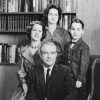calsfoundation@cals.org
Paul Van Dalsem (1907–1983)
Representative Paul Van Dalsem—with his cigars, his aggressive style, and his fiscal conservatism—came to represent the classic southern politician. He was a master of the legislative process and parliamentary procedure. This mastery served him well, allowing him to serve on and off for thirty years in the Arkansas House of Representatives.
Paul Van Dalsem was born in Aplin (Perry County) in 1907 to Pyke Van Dalsem and May Thompson Van Dalsem. He had one sister. He attended public school in Perryville (Perry County) and began college at what is now Arkansas Tech University before transferring to Louisiana Tech University in Ruston, Louisiana, where he earned his degree. He later attended the University of Arkansas (UA) in Fayetteville (Washington County), earning a degree that allowed him to join the university’s Cooperative Extension Service. He worked as a county agricultural agent and a farmer, as well as acquiring a number of businesses over the years, including the Perry County News, which was edited by his wife, Royce Irene Haydon Van Dalsem, whom he married in 1941. The couple had one son and two daughters.
First elected to the state House of Representatives in 1936 as a Democrat to represent Perry County and part of Pulaski County, Van Dalsem was known for his fiscal conservatism, his close alliance with Orval Faubus, and his ability to change his political tactics to fit any situation. He made three political comebacks: he was defeated in 1938, reelected in 1940, defeated once again in 1947, reelected in 1948 by a nearly two-to-one margin, defeated in 1966, and reelected in 1972.
Van Dalsem rose to become one of the most powerful members of the Arkansas General Assembly, holding a place on the powerful Arkansas Legislative Council during the 1950s and 1960s. A master legislator, he was known for filing multiple bills and allowing most to die in order to achieve his ultimate goals, a tactic he used to create the law school in Little Rock (Pulaski County). During the desegregation of Central High School, as the chair of the education subcommittee of the Legislative Council, he led a McCarthy-style investigation, even predicting the involvement of communists, which led to even greater harassment of proponents of integration. This investigation resulted in the “teacher purge” by the Little Rock School Board in 1959.
Comments concerning women’s participation in government and women’s rights are what Van Dalsem remains best known for. The Arkansas division of the American Association of University Women (AAUW) lobbied the legislature to enact a series of electoral reforms in the 1950s and 1960s, legislation directed at preventing election tampering and voter fraud. During a speech to the Optimist Club of Little Rock on August 27, 1963, Van Dalsem stated: “We don’t have any of these university women in Perry County, but I’ll tell you what we do up there when one of our women starts poking around in something she doesn’t know anything about. We get her an extra milk cow. If that don’t work, we give her a little more garden to tend to. And then if that’s not enough, we get her pregnant and keep her barefoot.” When the Arkansas Gazette reported his remarks on August 28, it created a firestorm.
Arkansas, like many states, did not have proportional representation for the legislature. At the time, each county elected a state representative with twenty-five seats apportioned among counties with higher populations; this practice gave a small county like Perry County—and its representative—disproportionate power. Beginning in 1962, the U.S. Supreme Court handed down two rulings, Baker v. Carr and Reynolds v. Sims, challenging such forms of apportionment. In 1965, federal courts ruled specifically on Arkansas’s apportionment in Yancey v. Faubus. The state was given until June 15, 1965, to develop a constitutional plan. The reapportionment board developed a plan with multimember districts. This plan paired Perry County with the more populous Pulaski County. Van Dalsem was subsequently defeated in the 1966 Democratic primary by Herb Rule, had emphasized Van Dalsem’s remarks about women and who went on to defeat Marion Burton in the general election. Van Dalsem also had a rocky relationship with Governor Winthrop Rockefeller during his time in office.
In the 1967 legislative session, Van Dalsem acted as though he had not been defeated. He took advantage of a House rule allowing former members on the floor during the session and continued to run bills he supported and oppose others; the House eventually amended the chamber’s rules to stop such actions. Elected once again in 1972, Van Dalsem entered a far different legislature than the bodies he had previously served in. In this session, he supported women’s groups and the Equal Rights Amendment. However, in 1976, he was defeated by Larry Mahan of Faulkner County.
Van Dalsem died on April 29, 1983, in Perryville after several months of poor health. He is buried near where he was born in Aplin.
For additional information:
Blair, Diane, and Jay Barth. Arkansas Politics and Government. 2nd ed. Lincoln: University of Nebraska Press, 2005.
“Paul Van Dalsem, 76, Dies.” Arkansas Gazette, April 30, 1983, pp. 1A, 15A.
Thompson, Robert. “Barefoot and Pregnant: The Education of Paul Van Dalsem.” Arkansas Historical Quarterly 57 (Winter 1998): 377–407.
Urwin, Kathy Kunzinger. Agenda for Reform: Winthrop Rockefeller as Governor of Arkansas, 1967–71. Fayetteville: University of Arkansas Press, 1991.
Ward, John. The Arkansas Rockefeller. Baton Rouge: Louisiana State University Press, 1978.
Rodney Harris
Fayetteville, Arkansas






Comments
No comments on this entry yet.